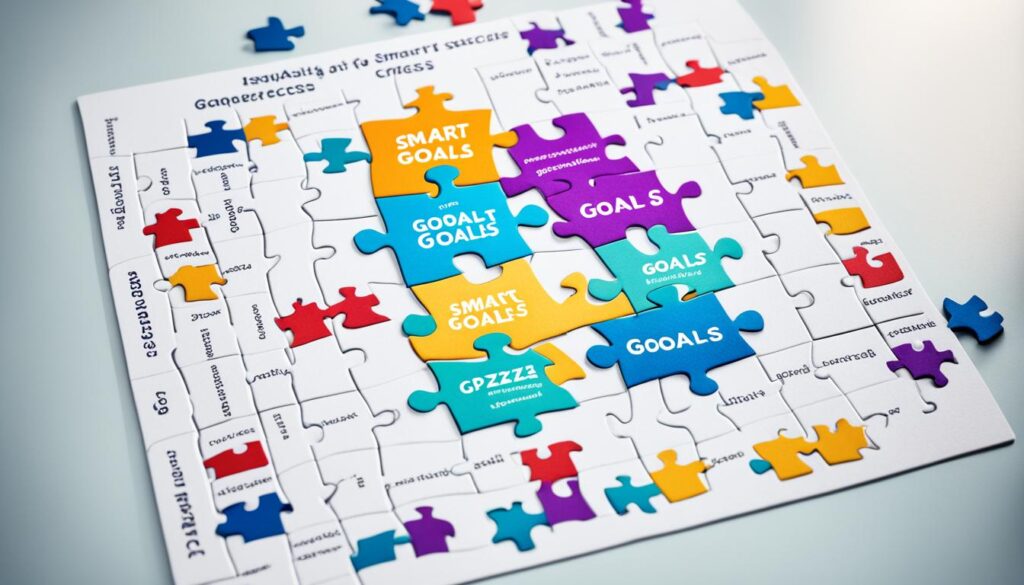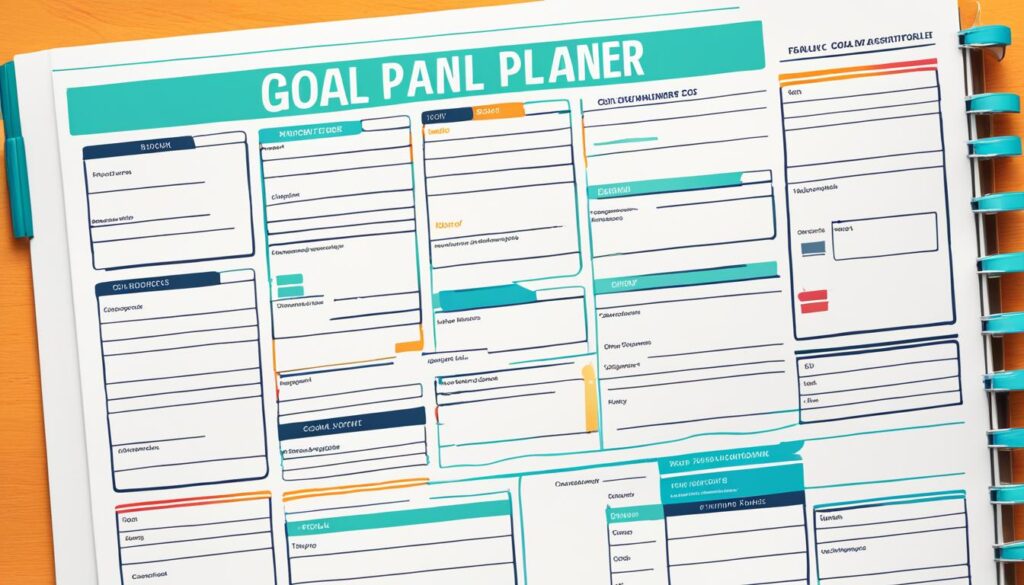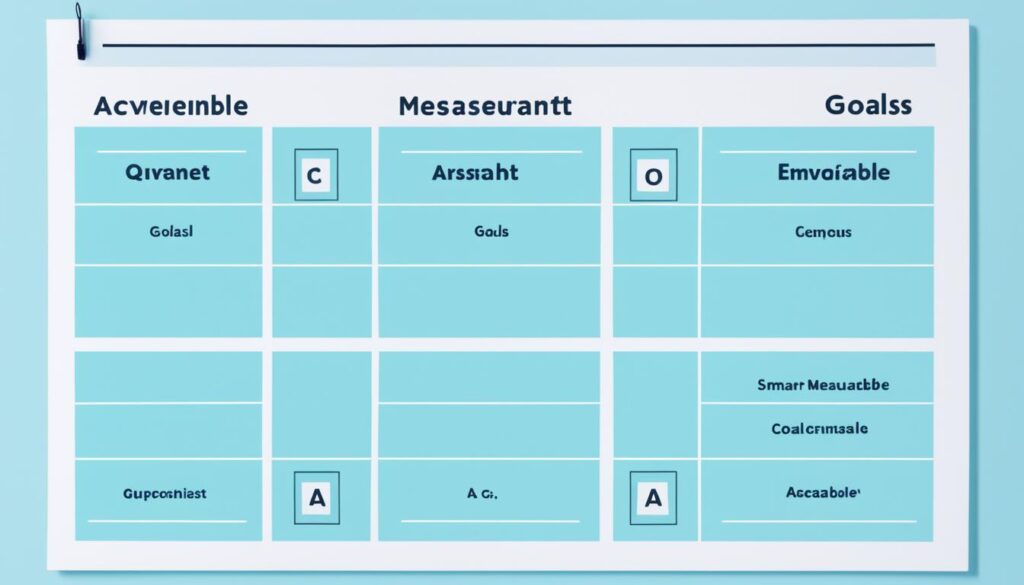Achieve Success with a SMART Goals Template

Do you want to achieve your goals more effectively? Are you tired of setting vague and unattainable objectives? It’s time to discover the power of SMART goals and how a SMART goals template can revolutionize your goal-setting process.
Setting goals is essential for personal and professional growth, but it’s crucial to set them with the right approach. Many people struggle to reach their goals because they lack clarity, measurement, and a concrete plan. That’s where SMART goals come in.
The SMART goals framework, which stands for Specific, Measurable, Achievable, Relevant, and Time-Bound, provides a structured approach to goal-setting. By using a SMART goals template, you can set objectives that are clear, trackable, realistic, and aligned with your aspirations.
In this article, we will explore the importance of setting SMART goals, delve into the SMART goals framework, and provide examples and tips to help you excel in your goal-setting efforts.
Key Takeaways:
- SMART goals provide a framework for setting clear and achievable objectives.
- A SMART goals template can help individuals set goals that are specific, measurable, and aligned with their aspirations.
- The SMART goals framework ensures goals are Specific, Measurable, Achievable, Relevant, and Time-Bound.
- Implementing SMART goals requires careful planning and consideration of the desired outcome.
- Using a SMART goals template promotes transparency, accountability, and collaboration within teams.
The Importance of Setting SMART Goals
Setting goals is essential for personal and professional growth, but it’s important to set them correctly. Many goals fail because they are overambitious, vague, or unplanned. The SMART goals framework provides a solution by ensuring goals are specific, measurable, attainable, relevant, and time-bound.
This framework helps individuals define their goals, measure progress, and increase their chances of success. SMART goals help individuals set clear objectives that are aligned with their values, skills, and overall business goals.
Why SMART Goal Setting Matters
When you set goals without a clear structure or criteria, it becomes challenging to track progress, measure success, and stay motivated. SMART goals provide a format that helps you create focused and attainable objectives. Here’s how each element of the SMART framework contributes to successful goal setting:
- Specific: SMART goals are specific in nature, clearly defining what you want to achieve. This level of specificity helps you stay focused and eliminates ambiguity.
- Measurable: By including measurable criteria, SMART goals allow you to quantify progress and determine when you’ve reached your desired outcome.
- Attainable: Setting realistic goals that are attainable ensures that you don’t create impossible expectations. It builds confidence and motivates you to take consistent action.
- Relevant: SMART goals are relevant to your overall aspirations, values, and long-term objectives. This alignment ensures that your efforts contribute to meaningful progress.
- Time-Bound: Including a timeframe or deadline in your SMART goals creates a sense of urgency and helps prioritize tasks. It prevents procrastination and keeps you accountable.
With the SMART goals framework, you have a clear roadmap to follow, allowing you to set achievable objectives that propel you forward.
Examples of SMART Goals
To provide you with a better understanding of how to structure your goals using the SMART framework, here are a few examples:
| Goal | Non-SMART Example | SMART Example |
|---|---|---|
| Career Development | Get promoted at work | Obtain a leadership position within my department by completing relevant training courses and taking on additional responsibilities within the next 12 months |
| Health and Fitness | Exercise more | Attend gym sessions three times per week for at least 45 minutes each, following a personalized workout plan and tracking progress using a fitness app |
| Personal Finance | Save money | Save $5,000 over the next 12 months by creating a monthly budget, reducing discretionary spending, and automatically transferring 20% of each paycheck into a dedicated savings account |
The examples above demonstrate how specific, measurable, attainable, relevant, and time-bound goals increase your chances of success and provide a clear path to follow.
Understanding the SMART Goals Framework
The SMART framework, introduced by George T. Doran in a 1981 article, revolutionized goal-setting by highlighting the importance of a systematic approach. Built on the acronym SMART, this framework breaks down the essential elements of a goal, ensuring clarity, focus, and achievable outcomes.
Specific
A goal must be specific, clearly outlining what you want to achieve. The more precise and well-defined your goal, the easier it becomes to create a roadmap and measure progress.
Measurable
To track your progress and determine success, goals should be measurable. Setting tangible metrics and milestones enables you to evaluate your achievements and stay motivated throughout the journey.
Achievable
A goal should be realistic and attainable. By considering your available resources, skills, and circumstances, you can set objectives that challenge you while remaining within reach.
Relevant
Aligning your goals with your long-term objectives is crucial for success. The relevance of a goal lies in its contribution to your personal growth, career development, or overall business strategy.
Time-Bound
Setting a deadline creates a sense of urgency and helps prioritize tasks. A time-bound goal provides a clear timeframe within which you can plan and execute your actions.
By understanding and employing the SMART goals framework, you can infuse your goals with intentionality and purpose, increasing your chances of success. This systematic approach allows you to set meaningful objectives that are well-defined, measurable, attainable, relevant, and time-bound.

Implementing SMART Goals
To implement SMART goals effectively, it is essential to utilize the right tools and resources. One such tool that can greatly assist you in the process is a SMART goal worksheet. This worksheet acts as a comprehensive guide, taking you step by step through the process of setting SMART goals using the SMART framework.
By using a SMART goal worksheet, you can:
- Define your goals: The worksheet prompts you to clearly identify your goals, ensuring they are specific and well-defined.
- Break goals into manageable steps: Dividing your goals into smaller, achievable tasks helps you stay focused and motivated throughout the process.
- Set deadlines: Assigning realistic deadlines to each step of the goal-setting process ensures progress is made in a timely manner.
- Identify obstacles and resources: The worksheet prompts you to consider potential challenges that may arise and identify the resources and support needed to overcome them.
Furthermore, examples of SMART goals can serve as both inspiration and guidance as you embark on your goal-setting journey. Seeing real-life examples of SMART goals can help you better understand how to structure and formulate your own goals.

| SMART Goal Example | Description |
|---|---|
| Increase monthly sales by 20% within six months | Develop and implement a comprehensive marketing strategy to drive sales growth and expand customer base. |
| Complete a marathon within one year | Follow a structured training plan, gradually increasing distance and pace, to build endurance and prepare for the marathon. |
| Read 30 books in a year | Create a reading schedule and allocate dedicated time each day to read, exploring a variety of genres and topics. |
| Launch a successful online business within six months | Conduct thorough market research, develop a strong brand identity, build a user-friendly website, and implement effective marketing strategies. |
Benefits of Using a SMART Goals Template
Using a SMART goals template offers numerous benefits for individuals and organizations. By clarifying ideas and focusing efforts, the template helps individuals work more productively and effectively. SMART goals promote transparency and accountability within teams, as everyone understands the expectations and progress of each goal. The template encourages collaboration and trust, as missed goals become opportunities for growth and skill development. SMART goals also break down larger objectives into smaller, manageable tasks, increasing motivation and the likelihood of success.
By utilizing a goal planner template, you can streamline your goal-setting process and ensure that your objectives meet the SMART criteria. With a clear structure and defined criteria, the template enables you to set goals that are specific, measurable, achievable, relevant, and time-bound. This results in goals that are not only well-defined but also aligned with your personal or organization’s larger vision.
With a goal planner template, you can:
- Organize your thoughts and ideas, ensuring a clear direction
- Break down complex objectives into manageable steps
- Set measurable milestones to track progress
- Establish realistic deadlines to maintain focus
- Align each goal with your values and strategic priorities
When using a SMART goals template, you empower yourself to pursue your ambitions with clarity and purpose. By leveraging the power of specificity, measurability, achievability, relevance, and time-bound objectives, you increase your chances of success while fostering accountability, collaboration, and personal growth.

Ready to take your goal-setting to the next level? Dive into the next section to learn how to write SMART goals effectively.
How to Write SMART Goals
Writing SMART goals requires careful consideration and planning. Follow these steps to create goals that are specific, measurable, achievable, relevant, and time-bound.
1. Define the Objective Clearly
Begin by clearly defining the objective of your goal. Whether it’s a personal or business goal, ensure that it aligns with your overall aspirations. This clarity will provide a strong foundation for your goal-setting efforts.
2. Establish Measurable Metrics
To track progress and determine success, it’s crucial to establish measurable metrics. These metrics should be quantifiable and allow you to monitor your progress along the way. By measuring your progress, you can stay on track and make necessary adjustments if needed.
3. Set Challenging Yet Achievable Goals
When setting SMART goals, aim for a balance between challenge and achievability. Avoid setting goals that are too easy or unrealistic. Consider your available resources and skills to ensure that the goals are realistic and within reach.
4. Assess Relevance to Overall Objectives
Before finalizing your goals, evaluate their relevance to your overall objectives. Ensure that they align with your values, interests, and long-term aspirations. This alignment will help maintain focus and motivation throughout the goal attainment process.
5. Establish a Timeline and Milestones
To provide a sense of urgency and prioritize tasks, establish a timeline with specific milestones and a deadline. Breaking down your goal into smaller milestones makes it more manageable and allows you to celebrate progress along the way.
Using a SMART goals template or worksheet can greatly facilitate the process of writing SMART goals. These resources provide structure and guidance, ensuring that you cover all necessary elements to create effective goals.

Now that you know how to write SMART goals, it’s time to put your knowledge into action. By following these steps and utilizing tools such as templates and worksheets, you can set clear, actionable goals that propel you towards success.
Conclusion
Setting SMART goals is essential for unlocking your full potential and achieving success in both your personal and professional endeavors. By utilizing a SMART goals template and adhering to the principles of specificity, measurability, achievability, relevance, and time-bound, you can establish clear and actionable goals that lead to meaningful outcomes. With the right mindset and a well-structured approach, you have the power to excel in your goal-setting efforts.
A SMART goals template serves as a valuable tool in guiding and organizing your goal-setting process. By applying the SMART framework, you ensure that your goals are specific, measurable, attainable, relevant, and time-bound. This framework empowers you to define your objectives, track your progress, and increase your chances of success. Additionally, looking at smart goal examples can provide inspiration and guidance as you navigate your own goal-setting journey.
Remember, setting SMART goals is more than just a checklist. It is a mindset that propels you towards growth and achievement. By incorporating the principles of the SMART goals framework into your planning and execution, you can steer your life and career in the direction of your dreams. Embrace the power of SMART goals, utilize a SMART goals template, and embark on a journey of continuous improvement and success.






